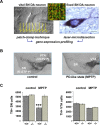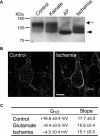Cellular excitability and the regulation of functional neuronal identity: from gene expression to neuromodulation
- PMID: 17035518
- PMCID: PMC6674680
- DOI: 10.1523/JNEUROSCI.3194-06.2006
Cellular excitability and the regulation of functional neuronal identity: from gene expression to neuromodulation
Figures





Similar articles
-
Neurotransmitter regulation of neuronal outgrowth, plasticity and survival in the year 2001.Trends Neurosci. 1995 Feb;18(2):71-2. doi: 10.1016/0166-2236(95)93877-z. Trends Neurosci. 1995. PMID: 7537415 Review. No abstract available.
-
Development of sympathetic neurons: neurotransmitter plasticity and differentiation factors.Prog Brain Res. 1994;100:19-23. doi: 10.1016/s0079-6123(08)60763-3. Prog Brain Res. 1994. PMID: 7938519 Review. No abstract available.
-
Neurotransmitter Switching? No Surprise.Neuron. 2015 Jun 3;86(5):1131-44. doi: 10.1016/j.neuron.2015.05.028. Neuron. 2015. PMID: 26050033 Free PMC article. Review.
-
Reserve pool neuron transmitter respecification: Novel neuroplasticity.Dev Neurobiol. 2012 Apr;72(4):465-74. doi: 10.1002/dneu.20920. Dev Neurobiol. 2012. PMID: 21595049 Free PMC article. Review.
-
Neuromodulation as a mechanism for the induction of repetition priming.Curr Opin Neurobiol. 2014 Dec;29:33-8. doi: 10.1016/j.conb.2014.04.011. Epub 2014 May 16. Curr Opin Neurobiol. 2014. PMID: 25261622 Free PMC article. Review.
Cited by
-
Reduced Neural Excitability and Activation Contribute to Clinically Meaningful Weakness in Older Adults.J Gerontol A Biol Sci Med Sci. 2021 Mar 31;76(4):692-702. doi: 10.1093/gerona/glaa157. J Gerontol A Biol Sci Med Sci. 2021. PMID: 32588058 Free PMC article.
-
Canard solutions in neural mass models: consequences on critical regimes.J Math Neurosci. 2021 Sep 16;11(1):11. doi: 10.1186/s13408-021-00109-z. J Math Neurosci. 2021. PMID: 34529192 Free PMC article.
-
Rapid homeostatic plasticity of intrinsic excitability in a central pattern generator network stabilizes functional neural network output.J Neurosci. 2012 Jul 11;32(28):9649-58. doi: 10.1523/JNEUROSCI.1945-12.2012. J Neurosci. 2012. PMID: 22787050 Free PMC article.
-
Blurring the boundaries: developmental and activity-dependent determinants of neural circuits.Trends Neurosci. 2013 Oct;36(10):610-9. doi: 10.1016/j.tins.2013.06.006. Epub 2013 Jul 19. Trends Neurosci. 2013. PMID: 23876426 Free PMC article. Review.
-
Intracellular gold nanoparticles increase neuronal excitability and aggravate seizure activity in the mouse brain.PLoS One. 2014 Mar 13;9(3):e91360. doi: 10.1371/journal.pone.0091360. eCollection 2014. PLoS One. 2014. PMID: 24625829 Free PMC article.
References
-
- Andrews ZB, Diano S, Horvath TL. Mitochondrial uncoupling proteins in the CNS: in support of function and survival. Nat Rev Neurosci. 2005;6:829–840. - PubMed
-
- Baines RA. Neuronal homeostasis through translational control. Mol Neurobiol. 2005;32:113–121. - PubMed
-
- Baines RA, Pym EC. Determinants of electrical properties in developing neurons. Semin Cell Dev Biol. 2006;17:12–19. - PubMed
-
- Brezina V, Weiss KR. Functional consequences of divergence and convergence in physiological signaling pathways. Mol Psychiatry. 1997;2:9–11. - PubMed
Publication types
MeSH terms
Substances
LinkOut - more resources
Full Text Sources
Molecular Biology Databases
